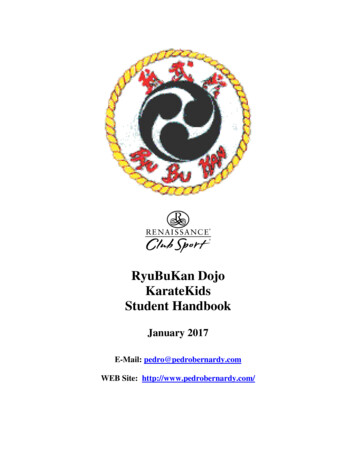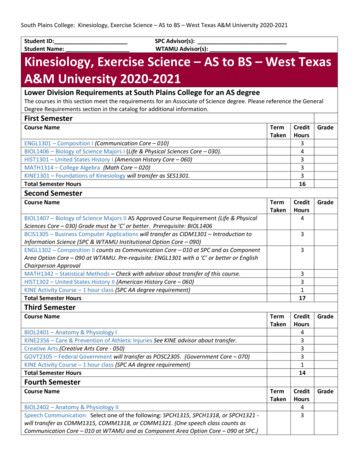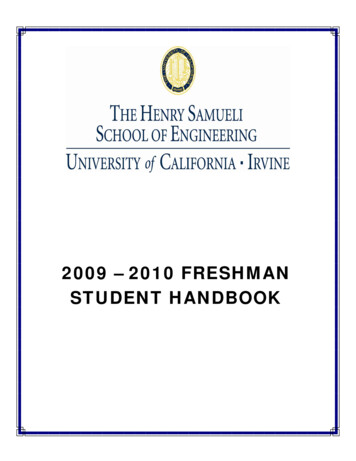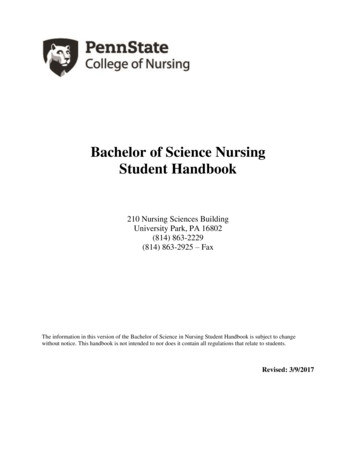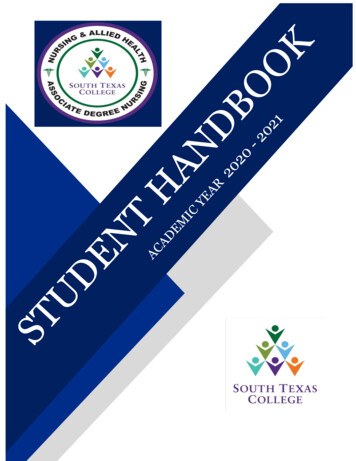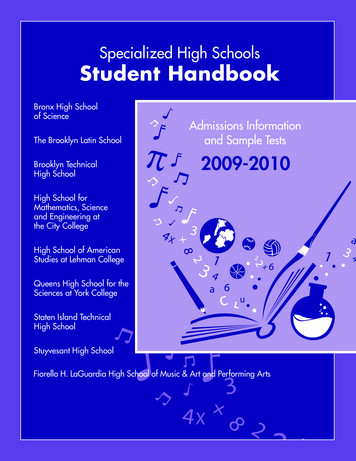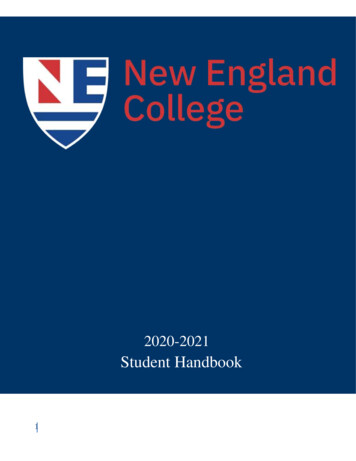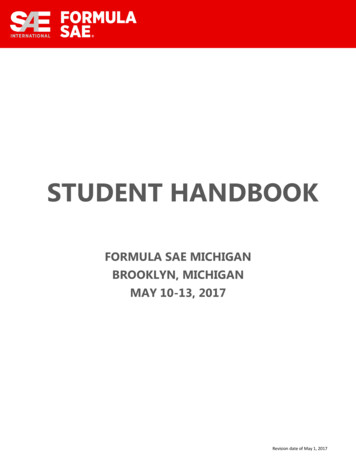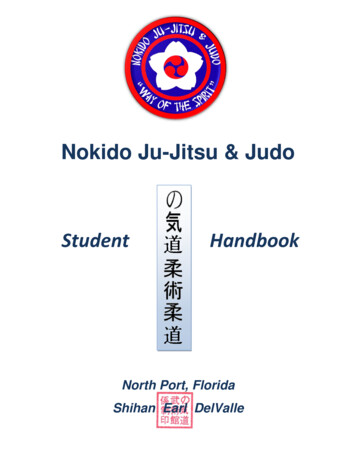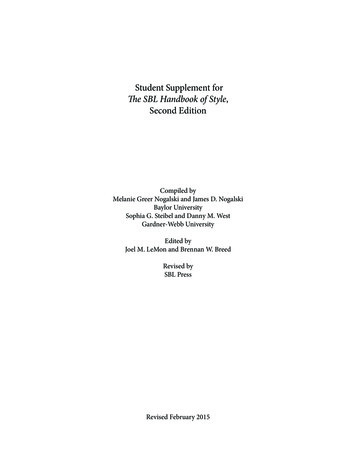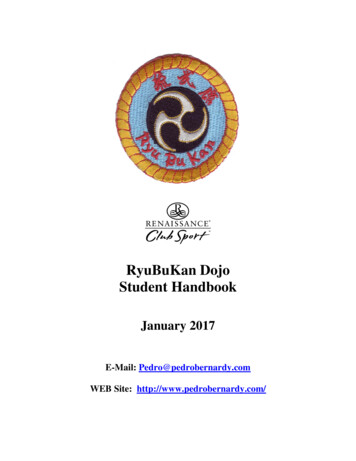
Transcription
RyuBuKan DojoStudent HandbookJanuary 2017E-Mail: Pedro@pedrobernardy.comWEB Site: http://www.pedrobernardy.com/
RyuBuKan DojoStudent Handbook2
RyuBuKan DojoStudent Handbook1.0 Table of Contents1.0 Table of Contents . 32.0 Introduction: Dojo and Instructor . 52.1 The RyuBuKan Dojo . 52.2 Instructor's Resume: Pedro J. Bernardy . 62.3 Registration Form . 83.0 Martial Arts History (condensed version) . 103.1 Shorin-Ryu Karate . 103.2 Kobudo. 103.3 Small Circle Jujitsu . 104.0 General Rules & Information. 114.1 Class Times . 114.2 Class Fees . 114.3 Class Locations: . 114.4 How to Tie Your Belt . 125.0 Dojo Etiquette. 136.0 Ranking Requirements . 146.1 Yellow Belt (7th Kyu). 146.2 Blue Belt (6th Kyu). 156.3 Green Belt (5th Kyu). 166.4 Green w/Brown Stripe Belt (4th Kyu) . 176.5 Brown Belt (3rd Kyu) . 187.0 Kata Descriptions (written by GoJu-Ryu karate teacher, Higaonna Morio) . 197.1 KARATE KATA . 207.2 KOBUDO KATA . 218.0 Self-defense Technique Descriptions . 228.1 Blue Belt (6th Kyu) . 228.2 Green Belt (5th Kyu, 4th Kyu) . 228.3 Brown Belt (3rd Kyu, 2nd Kyu, 1st Kyu) . 228.4 Black Belt (1st Dan) . 229.0 Takedown Descriptions . 2310.0 Complex Stance Patterns . 243
RyuBuKan DojoStudent Handbook11.0 Jujitsu Technique Descriptions . 2512.0 Kicking Technique Descriptions . 2613.0 Hand Technique Descriptions . 2714.0 Martial Arts Terminology/Dictionary . 28Martial Arts Dictionary Japanese to English . 28Counting .28A .28B .28C .29D .29E .29F .29G .29H .30I.30J .31K .31L .32M .32N .33O .33P .34Q .34R .34S .34T .35U .35V .36W .36X .36Y .36Z .371414.1Student Contributions: Research, Articles of interest, etc. . 38“The Endless Path” - contributed by Pedro Bernardy . 384
RyuBuKan DojoStudent Handbook2.0 Introduction: Dojo and Instructor2.1 The RyuBuKan DojoMission Statement: To promote the arts and culture of Okinawa, particularly thoserelated to the martial arts; to embrace all other cultures and their indigenous methods ofself-defense; to provide a safe, effective, and enjoyable experience for a lifetime study ofmarital arts.Dojo History: The RyuBuKan Dojo was established by Pedro J. Bernardy as a means forgiving back to his instructors and their arts. The name Ryu Bu Kan is formed from theRyukyu culture from which the basis of our studies originate (RYU), the expression ofmartial art as a way of life (BU), and a home for all who wish to learn and share fromthese efforts (KAN). The RyuBuKan Dojo is a family affair where lessons are earned byconsistent effort and positive attitude. Students come and go but our hope is that thestrength and sincerity learned here will carry them through all of life's challenges.Curriculum: Students receive instruction in Okinawan Karate and ancient weapon artsknown as Kobudo, and in the basics of Small Circle Jujitsu. Our Karate practice is basedon a curriculum of technique from Okinawan styles called Shuri-Te, Naha-Te, andTomari-Te. Jujitsu basics taught in the RyuBuKan Dojo are from Jim Silvan Senseiand his teacher, Professor Wally Jay, founder of Small Circle Jujitsu. There are twosystems of Kobudo practiced in our studio; Matayoshi Family style as taught by KimoWall Sensei and his teacher, Matayoshi Shinpo Sensei, and Yamanni-Ryu as taught bySilvan Sensei and his teacher, Oshiro Toshihiro Sensei.5
RyuBuKan DojoStudent Handbook2.2 Instructor's Resume: Pedro J. BernardyMartial Arts Background: I began formal martial arts training in 1973 with GeorgeDillman in the style known as Okinawan Kempo Karate. My initial desire was to acquire theincredible skills I witnessed from my teachers, coupled with a practical need to defendmyself. I soon learned that it requires much more skill to keep from fighting, and that themartial arts are intended as a life-long endeavor.I continued my training after moving to Chicago in 1974. The studio was the Ali KaiAcademy in Maywood, Illinois, where I was taught the basics of Shuri-Ryu karate. Myteachers were students of Robert Trias, including Bill and Bernice Downs, who conductedclasses that required no less than 100% commitment. These were serious, hard-hittingsessions that I believe are seldom seen in today's commercial dojo setting. Unfortunately theAli Kai Academy closed just a few months of my joining due to the sudden death of itsfounder, Pat Wyatt. For the next two years I studied Chinese Kenpo in a local studio of theTracy Brothers system and practiced what I could with friends and family.In 1976 I moved to California where by a stroke of great fortune met several martial artleaders of the Okinawan community in Los Angeles. Among these special individuals areTakushi Yasukazu, Oyakawa (Roy) Shogen, Kimo Wall, and Kenneth L. Penland. Theseteachers showed me the beauty that is Ryukyu culture; its folk dance and music, proudhistory, and many other treasures previously unknown to me. I will be forever in their debitfor what they shared. The RyuBuKan Dojo is a small measure of payment for theircontributions to the martial arts and to me personally.After gaining black belt ranking in Okinawan arts I sought to gain a greater appreciation ofrelated disciplines. I studied Japanese Karate, Calligraphy, Tea Ceremony and language. Ialso trained in martial arts from other cultures including Chinese Kenpo, Korean Tae KwanDo and Tang Soo Do, and Filipino Eskrima. Since 1991 I have taught and trained inNorthern California, both privately and in the public sector. My students come in all agesand levels of martial arts experience. I continue my own training primarily with Jim Silvan,and am honored to have friends and mentors that include Oshiro Toshihiro, Professor WallyJay, Matayoshi Shinpo, Nakamura Yoshio, and Shinzato Katsuhiko. In 2010 I began seriousstudy of Hunyuan Tai Chi to further my understanding of this influence on the Okinawanmartial culture.Of all the many benefits I have thus far derived from my training, it is the support andinvolvement of my wife, Junko, daughters and students Julia Ai and Christina Machiko, andthe members of the RyuBuKan Dojo that provide me the most sense of accomplishment.6
RyuBuKan DojoStudent HandbookSTUDENT REGISTRATION FORM (SEE NEXT PAGE)Please complete and return to your instructor at next class meeting7
RyuBuKan DojoStudent Handbook2.3 Registration FormRyuBuKan DojoStudent Registration FormStudent Name: Age
Martial Arts Background: I began formal martial arts training in 1973 with George Dillman in the style known as Okinawan Kempo Karate. My initial desire was to
